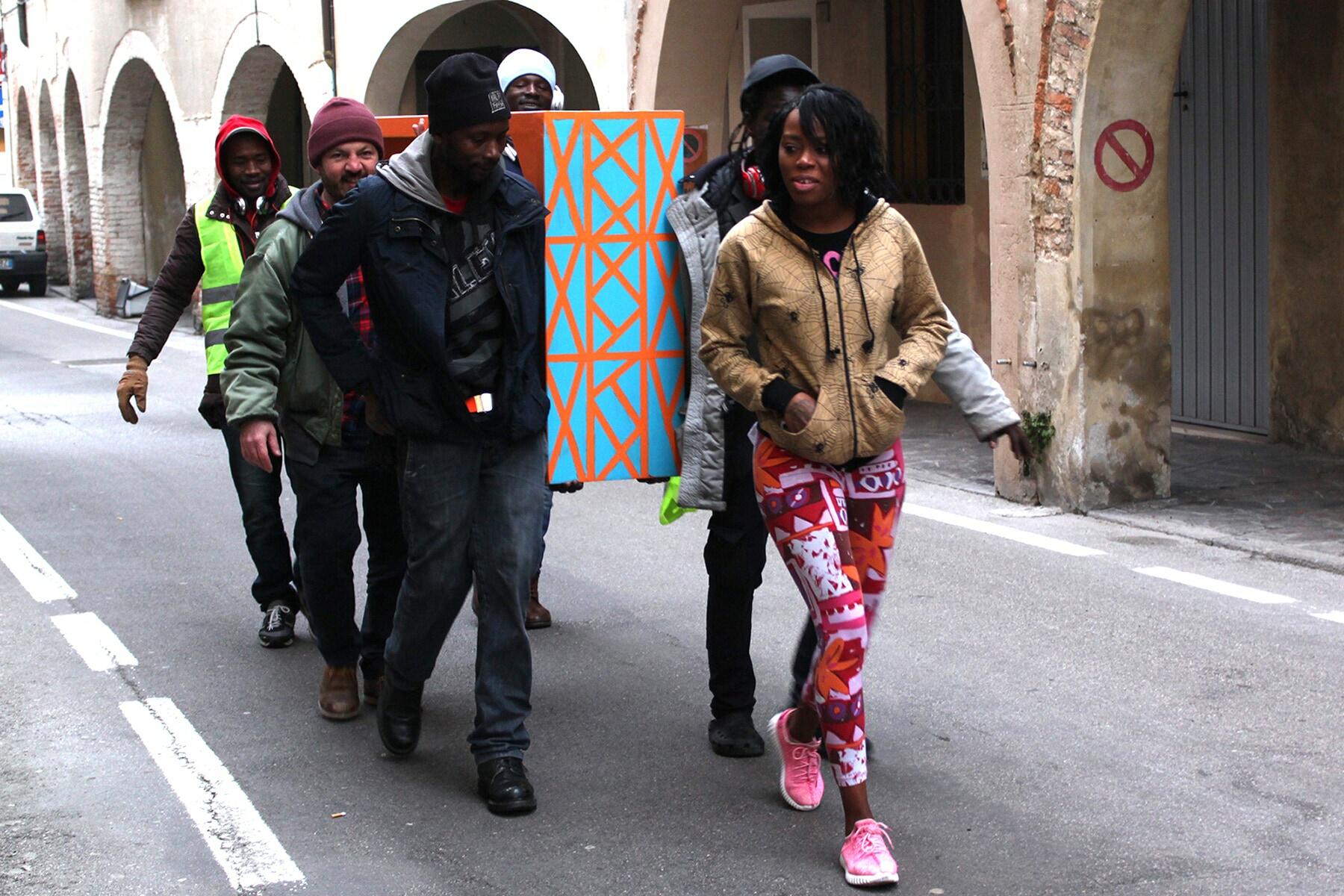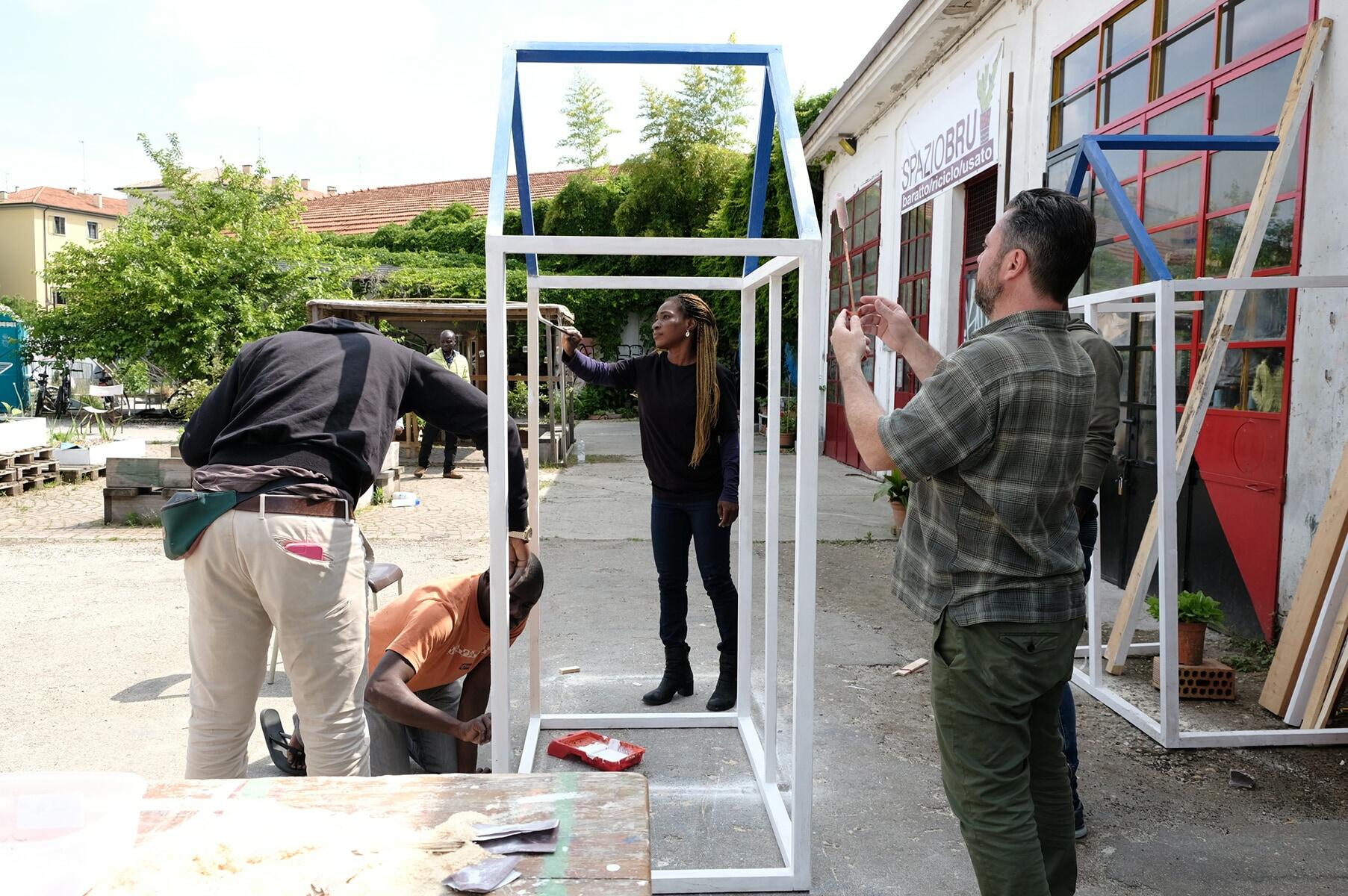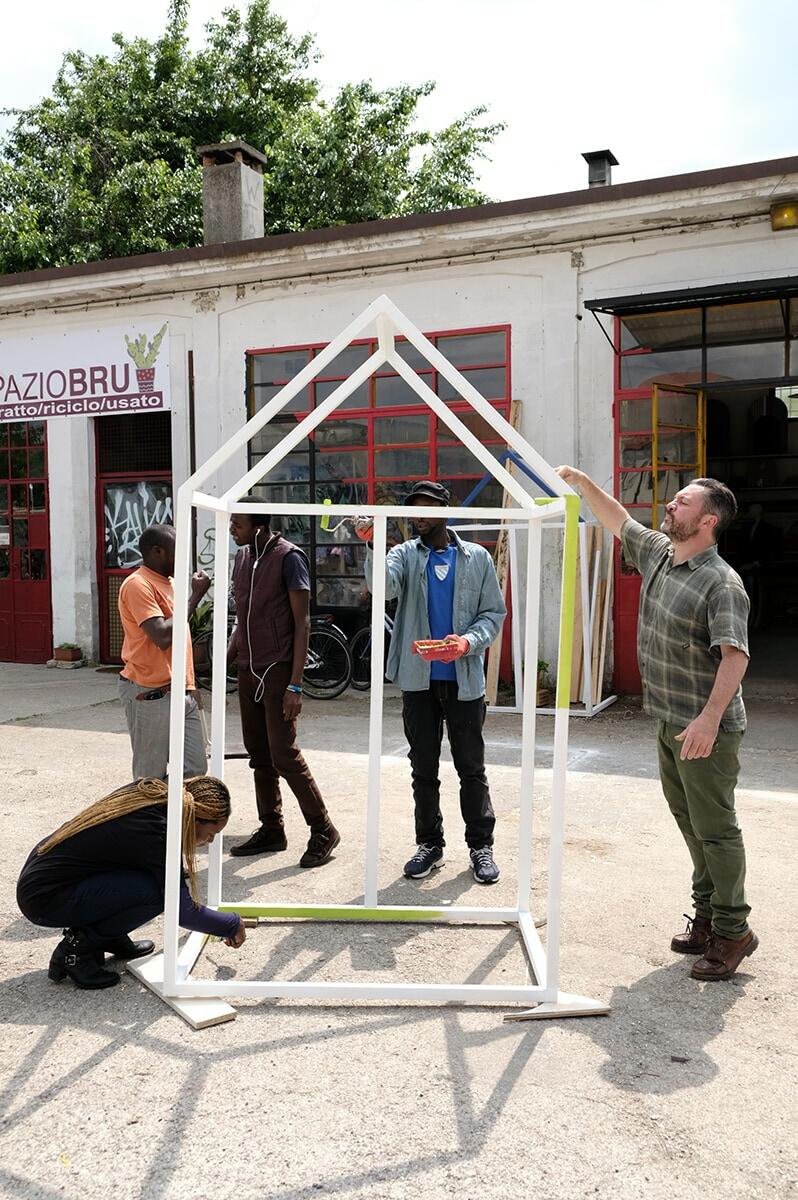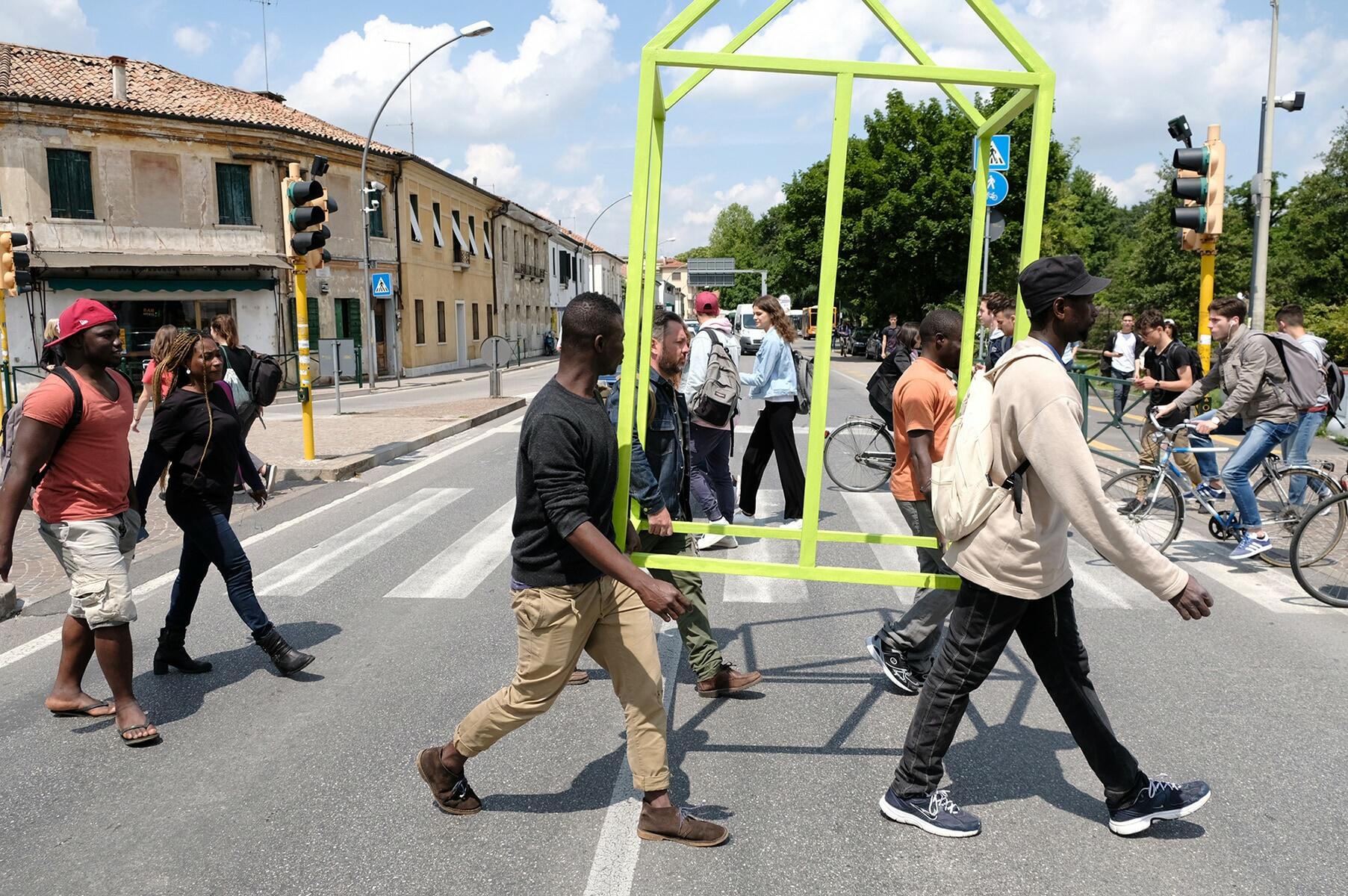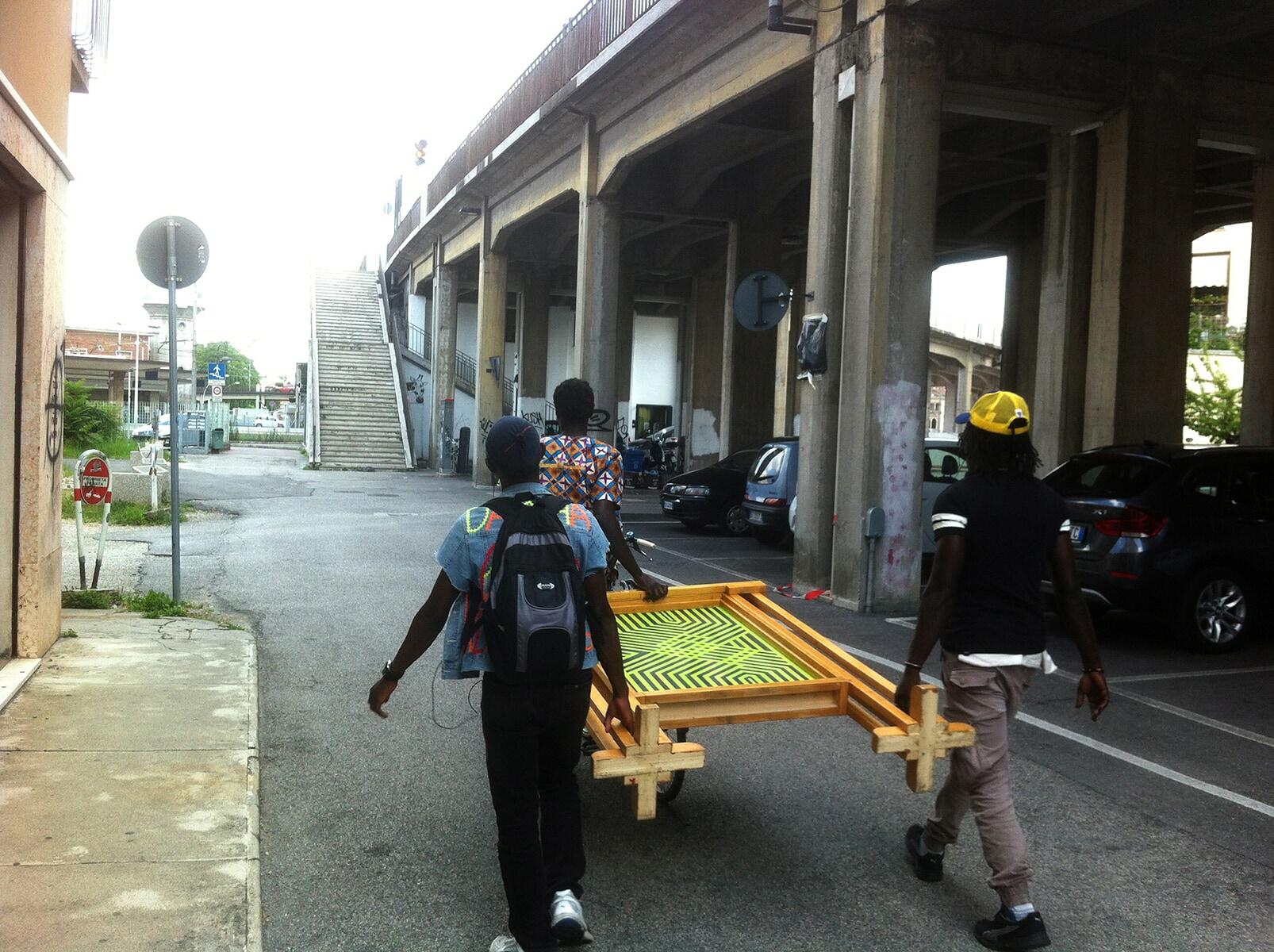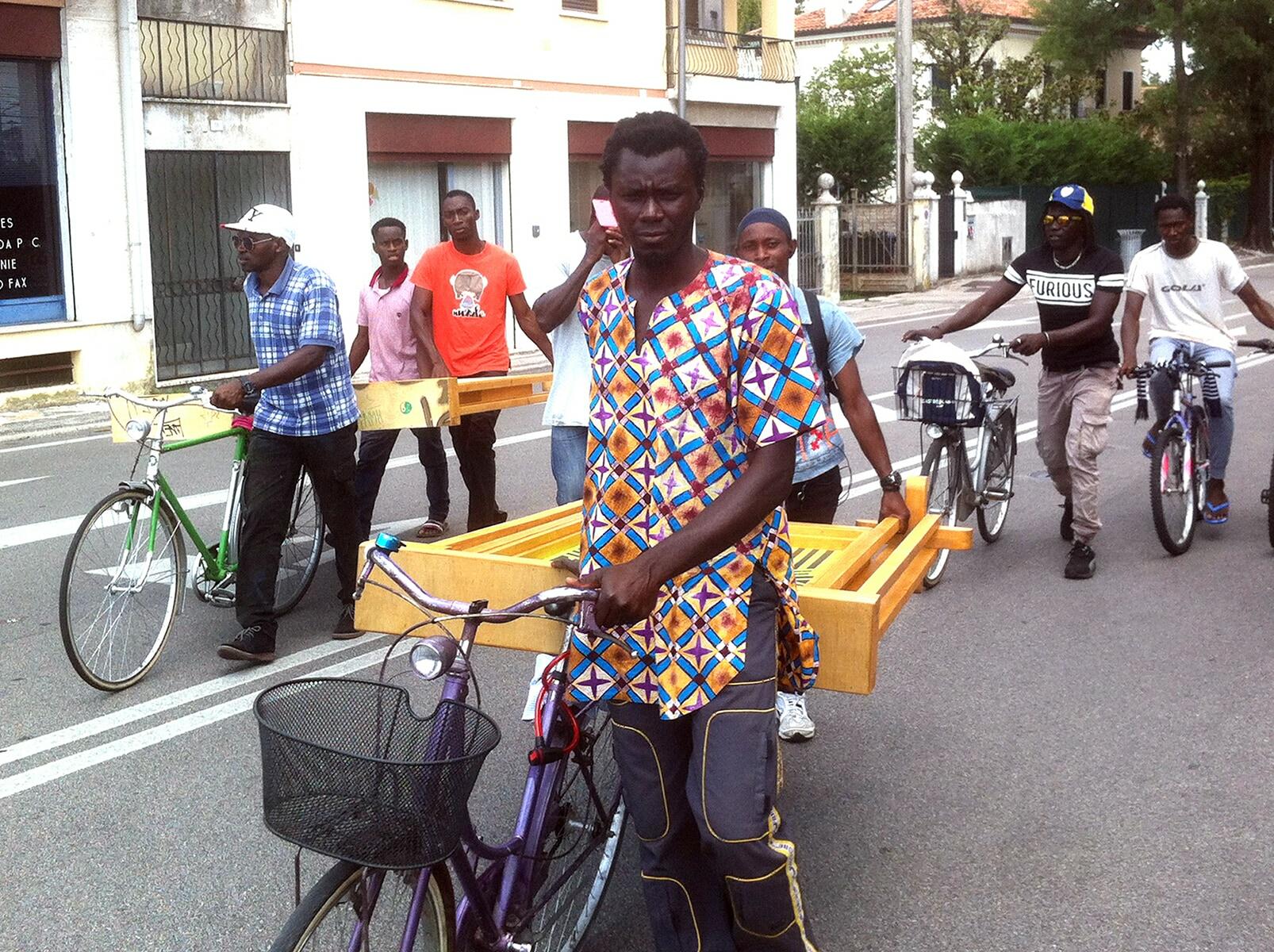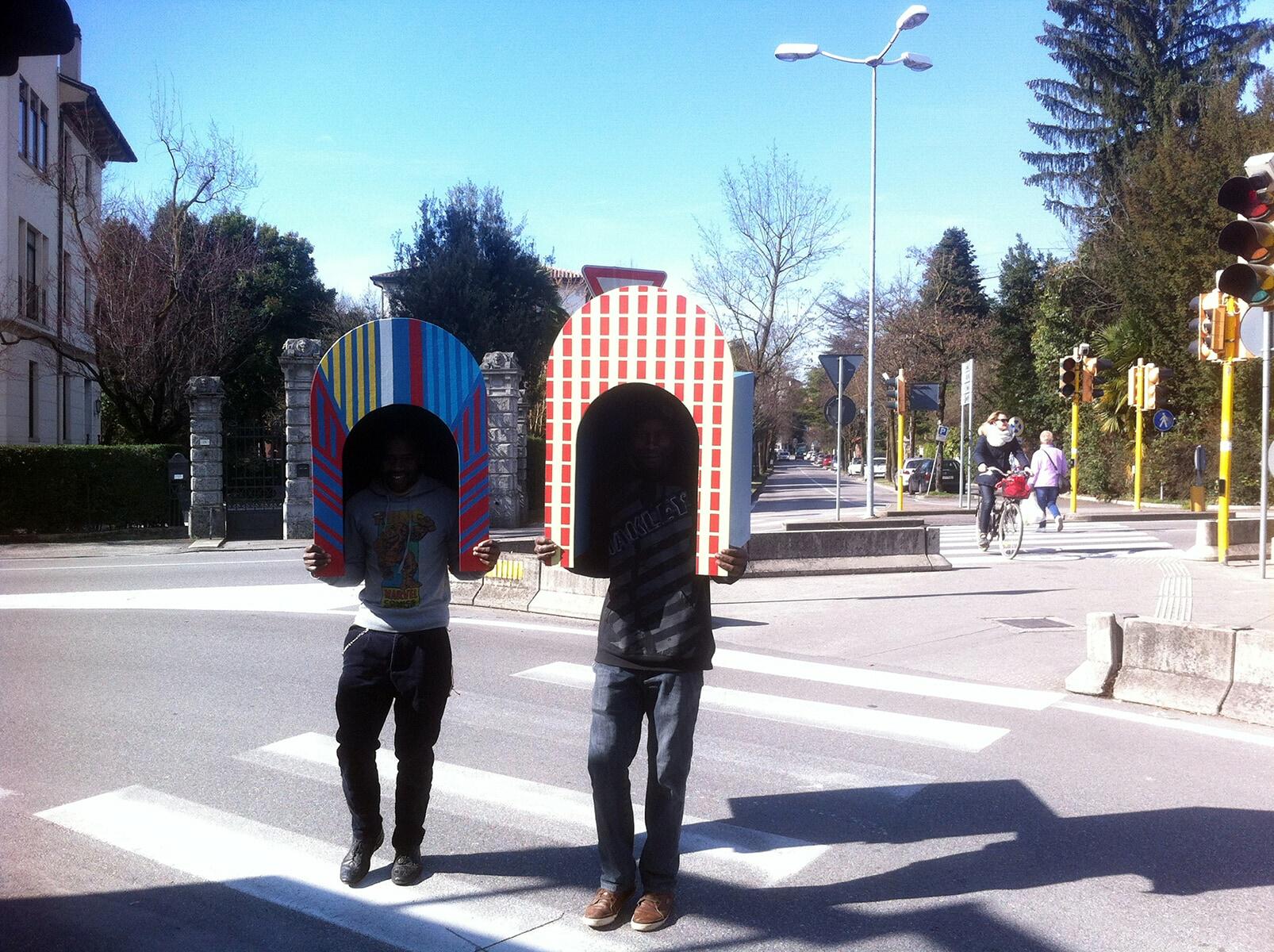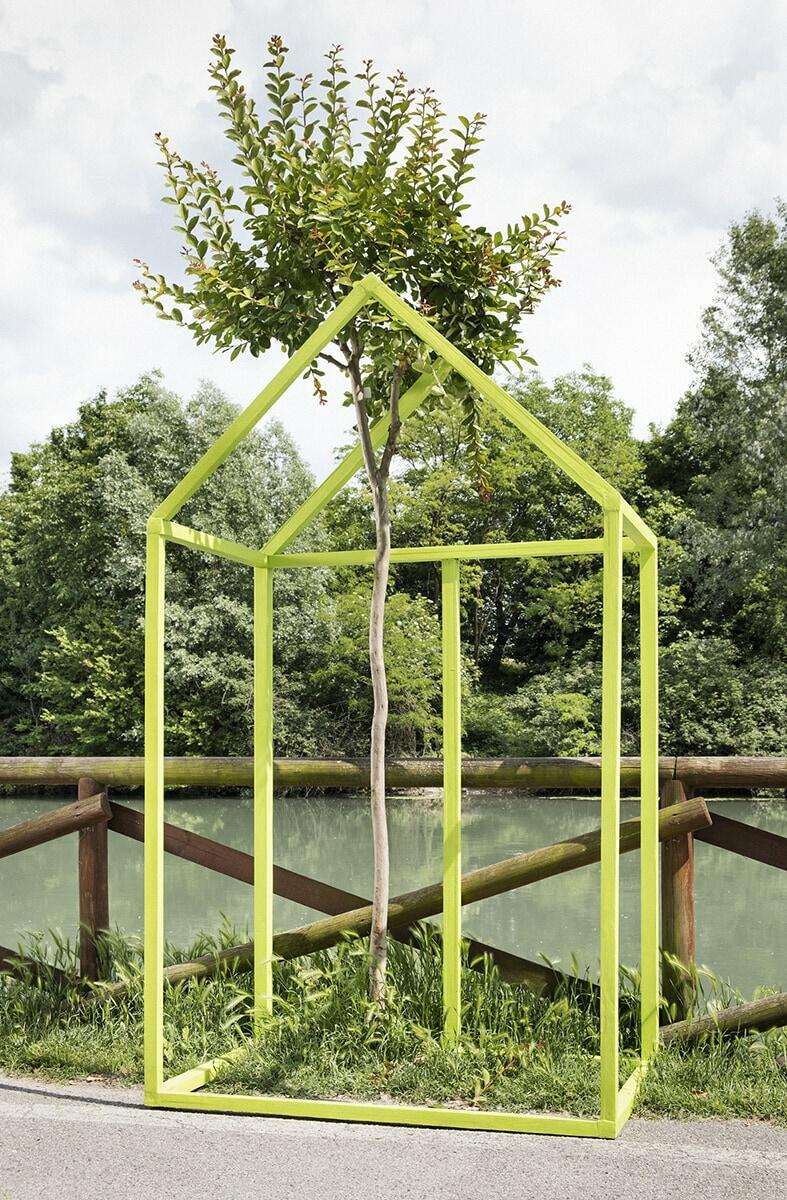Talking Hands’ urban wanderings:
a new “sharing of the sensitive”
In 2016, Talking Hands was born in Treviso, a design and social innovation laboratory that aims to encourage the inclusion of refugees through the creation and realisation of artistic projects, both on an individual and collective scale. Since the beginning of the adventure and until the end of 2018, the members of the group – mostly from sub-Saharan Africa – have been at the origin of the organisation, in a spontaneous way, of more than fifteen urban walks. Most of them were located in the Veneto region, and were as much gestures of resistance as they were ways of taking over the territory. Classic street demonstrations, such as protests in defence of refugees1 rights, are echoed by white marches in homage to the deceased linked to the journeys or experiences of migration policies2, or by “home deliveries”3 of collections or objects made solely by the strength of arms and legs, a real custom at Talking Hands. Sometimes the Actions turn into a real performance. For example, on 17 July 2018, on the occasion of their last gathering, the refugees formed a huge funeral procession headed by a coffin they had made and carried themselves4. A strong, shocking gesture, closely linked to their personal experiences of migration and inviting reflection on mourning and funeral rites around the world.
Urban strolling: a “quest for visibility”
“The body in movement in urban space is not only that of the legs but above all that of the eyes and the mind”, reports Giampaolo Nuvolati, professor of sociology of the environment and the territory at the University of Milan Bicocca. This reflection, which testifies to the prevalence of the visual register in the very action of walking, is of prime importance when put into perspective with the definition of the observer formulated by Jonathan Crary. For him, it is “above all a person who sees within a predetermined set of possibilities, a person who is inscribed in a system of conventions and limitations”5. Yet, like other minorities in the course of history, refugees are today excluded – at least partially – from the public space. Their living space, their very possibility of movement, is limited to restricted geographical areas. In Treviso, for example, this area extends from the outskirts of the station to the barracks where they live6. Outside this perimeter, police controls are more frequent, instilling a climate of fear that is unfavourable to going out and discovering things7. This question of unequal access to the territory, of physical, visual and symbolic limits, of border spaces, has been a central issue in urban demonstrations from the start. They allow the territory invested to be extended by annihilating, for a time at least, spatial restrictions. During the walks in the neighbourhood, we probe the space ‘with our eyes”8, says Fabrizio Urettini, artistic director of Talking Hands. In the case of the “home deliveries”, the furniture and coloured objects carried on the back serve as a sort of “temporary passport” to avoid prohibitions and police surveillance9. The exceptional situation of moving 20 to 30 people at the same time, coupled with the image of the “honest worker” carrying goods that he had made himself, was undoubtedly a factor in this. This [re]conquest of space is the corollary of a “struggle for recognition”10 (Honneth) and even for existence within the social body.
The organisation of the group’s first rally, on 29 September 2016, coincided with the first notable appearance of the refugees in the city. On that occasion, the procession strolled through the streets of the city centre before parking for a long time in one of the agora’s key squares: Piazza dei Signori, located in front of the prefecture – which is responsible for issuing precious residence permits. This Action, a real tour de force at the very origin of the official creation, a few weeks later, of Talking Hands, materialises as much as it anchors the presence of refugees in the urban, political and media space. It testifies to a quest for visibility that responds to the anonymity felt, individually and collectively, by the exiles: “Unlike previous migrations, which were different in nature, today’s exiles, the migrants – to be pronounced in one breath, the-migrants, almost in homophony with emigrant – are perceived as a block, which erases all subjectivity and individuality from the arrivals”11 notes Alexis Nuselovici. For Maxime Boidy, lecturer in visual studies at the University of Paris-Est, “history demonstrates the inseparable nature of struggles for visibility and strategies of opacity in revolt”12: “if there is a malaise haunting our societies,” he explains, “it is more a ‘malaise in visibility’ that is palpable through the multiplication of scholarly, militant and ordinary uses of this term”13. In his work, he has thus endeavoured to show how certain recent political practices – such as the Yellow Vest movement in France – embody a struggle for representation in order to appear not only “optically but also politically in the eyes of the state”14. To this end, the waistcoat offers “those who wear it [the possibility] of a complete symbolic reversal”15. These lines of thought are all the more relevant for analysing the Actions of Talking Hands as the refugees have also embarked on a project to reappropriate the yellow safety waistcoat. In their hands, it has become a reversible fashion accessory adorned with wax (Alta Visibilità project). Fabrizio Urettini explains: “this originally neutral and functional object now plays an important role as a ‘visibility indicator’. Modified in this way, it questions our perception of this group of individuals [refugees] that society tends – most often voluntarily – to ignore”16.
From “militant counter-visuality” to the right to see
The various forms of struggle led by Talking Hands could be likened to what Nicolas Mirzoeff calls “militant counter-visuality”17, “performance being what makes this right visible”18. Based on an analysis of Derrida’s Droits de regards (1985), this professor of media, culture and communication at New York University calls for the affirmation of “a right to look” that “does not consist in claiming authority but in claiming autonomy”19: “militant counter-visuality. We visualise another world, we work to create it. We seek the autonomy of the right to see, we want to escape the visuality of great men. In a word, a new sharing of the sensible must take place, which must not be described or analysed but made”20. Among the examples cited by the author to illustrate his point are Rosa Parks’ famous gesture in Montgomery in 1955, the occupation of Tahrir Square in Cairo in 2011, Puerta del Sol Square in Madrid (2011) and Zuccotti Park in New York (2011). This new way, which he calls for, if it intends to reconfigure the common space, also engages a reflection on the asymmetries of representation and power that are exercised in social and political life. Moreover, the collective initiatives mentioned are all based on a functioning similar to that observed by the Talking Hands community since its inception: the existence of an autonomous, self-managed group, where the horizontality of relations and the sensitive exchange between actors with different experiences and itineraries take precedence.
The philosopher Oskar Negt, a major figure of Frankfurt critical theory and author of “Oppositional Public Space”, has also testified on many occasions to the “key role that [he] attributes to public space in the production of a consciousness of our time”21: it “is one of the decisive elements of resistance and the formulation of alternatives”. Not so much for the recurrent marching of demonstrators during political protests, but rather because it bears the potential for emancipation of the collective, as long as the ‘oppositional practices’ of which it is the scene are accompanied by discussions, debates and exchanges, a ‘sketch of a creative process’22, in his own words. A principle [found] at the very heart of the activity [ambitions] of Talking Hands.
Talking Hand and the “state of encounter”
As Fabrizio Urettini states, “from the beginning, we have tried to create situations and configurations that allow people to talk to us and use the objects we make. And people really come and talk to us, even stop their car to talk (during home deliveries, for example). The same goes for meetings in more fixed places when we make our creations available”23. This dynamic is particularly evident in the Rifugiati series, a collection of small domestic architectures with a strong graphic connotation. Created in collaboration with designer Matteo Zorzenoni, the recycled materials used in the collection are enhanced with textures and patterns that evoke the different countries from which the refugees come. The furniture, which can be arranged to create large play areas, is designed primarily for children. The latter easily appropriate the device, as shown by their reactions during the various urban walks or open-air festivals. Beyond the playful and sensory experience, a spontaneous dialogue is also established between the young users, their parents and the refugees. This exchange makes it possible “to get in touch with people who would not necessarily have adhered to the project at first sight”24, to communicate with them in order “to facilitate mutual understanding”25 but also to extend the design process itself. The process is reminiscent of the “relational aesthetic” theorised by Nicolas Bourriaud in his 1998 manifesto26. In this essay, the art critic defended the idea that a large part of artistic production since the beginning of the 1990s has tended towards an aesthetic of the encounter, of the inter-human, of proximity, of interactivity. This vision reverses the paradigmatic field of art, which is intrinsically devoted, historically, to the domain of representation. In the case of Talking Hands, the “state of encounter” is furthermore supported by a process of “cultural hybridity”27 (Homi Bhabha), which is affirmed both at the design stage (through the collaboration between Italian designers and refugees of African origin) and at the moment of the object’s production and distribution. In this respect, the testimony of Kebba Sillah, a Gambian refugee and an integral part of Talking Hands since the beginning, speaks for itself: “For us, there is no problem of language or religion. We come from different countries, but we can communicate without any problems. We all work with a common direction, it’s easy”28.
Thus, the urban wanderings of Talking Hands, while certainly not capable of completely overturning the established order or the structural inequalities that exist within it, do contribute to a reflection on the latter and, in particular, on the relationships of visibility and invisibility at work in our contemporary societies. They also open the way to the visualisation of another possible world by helping to change the way we look at migration. This change is fostered by the dynamic exchange between the refugees and the public, but also by the narration of their experiences in works conceived in a wider field. It is this particular process that allows the exiles to seize this “third space” dear to Homi Bhabha. A true interstitial passage, “[it] disrupts the histories that constitute it and establishes new structures of authority, new political initiatives, that escape common sense”29.
Sabrina Dubbeld
1 These included the “Protest” demonstration (Treviso, 29 September 2016) and a march in Venice on 29 March 2017.
2 For example, on 27 January 2017, Talking Hands went to Venice to lay a wreath in honour of Pateh Sabally, a young refugee from Gambia who had died five days earlier in Venice’s Grand Canal, in front of a hundred passers-by.
3 Most of the “Livraisons à domicile” date from the winter of 2016-2017.
4 See the article Bara colorata costruira dai profughi per la start up “Un elemento d’arredo”,
in “Corriere del Veneto”, 18 July 2018.
5 Jonathan Crary (trad : Frédéric Maurin), Techniques de l’observateur. Vision et modernité au XIXe siècle, Bellevaux: Dehors, 2016, p. 33.
6 Precisely the Hub, Centro di Accoglienza Straordinaria, is called “ex Caserma Serena”.
7 According to an interview with Fabrizio Urettini.
8 Ibidem.
9 Ibidem.
10 For the links between the struggle for recognition and democratic public space, see Axel Honneth, Kampf um Anerkennung, Frankfurt am Main: Suhrkamp, 1997 and Alexander Neumann, Conceptualising Oppositional Public Space, in “Variations”, n°19, 2016.
11 Alexis Nuselovici (Nouss), Le principe du nulle part, paper presented at the colloquium “Faire projet, faire ensemble”, 7 February 2020, École Nationale Supérieure des Arts Décoratifs (excerpt sent by him to the author). See also, on this subject, Alexis Nouss, La condition de l’exilé, Penser les migrations contemporaines, Paris: Maison des Sciences de l’Homme, 2015, p. 192.
12 Text by Maxime Boidy dedicated to the Gilets Jaunes (to be published).
13 Maxime Boidy, Luttes de représentation, luttes de visibilité. Notes on the political iconography and iconology of the dominated, in “Hybrid. Revue des arts et médiations humaines”, Labex Arts H2H/Presses Universitaires de Vincennes, 2017.
14 Text by Maxime Boidy dedicated to the Gilets Jaunes (to be published).
15 Ibidem.
16 According to an interview with Fabrizio Urettini.
17 Nicolas Mirzoeff, Enfin, on se regarde ! Pour un droit de regard, in Politiques visuelles, Dijon: Les presses du réel, 2016, p. 43.
18 Ivi, p. 35.
19 Ibidem.
20 Ivi, p. 43.
21 Oskar Negt, L’espace public oppositionnel aujourd’hui, in “Multitudes”, 2009/4 (n°39), p. 195.
22 Ibidem.
23 According to an interview with Fabrizio Urettini.
24 Ibidem.
25 Ibidem.
26 Nicolas Bourriaud, L’esthétique relationnelle, Dijon: Les presses du réel, 1998, p. 128.
27 Homi K. Bhabha, Jonathan Rutherford, Le tiers-espace, in “Multitudes”, 2006/3 (n°26), p. 95.
28 Kabba’s words quoted by Marco De Vidi, Design più funzionale, in “Il manifesto”, 8 February 2017, n.p.
29 Homi K. Bhabha , op. cit.
